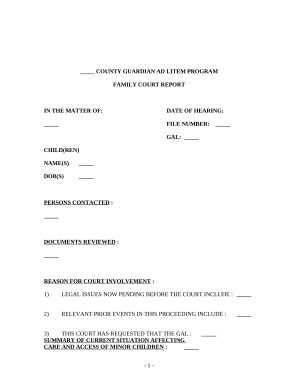What You Need to Know About Minnesota Family Court Procedures
The Minnesota family court system handles various cases, including divorce, child custody, and spousal support. The goal of the court is to resolve family disputes in a fair and just manner. Whether you’re dealing with a separation or issues involving children, knowing how the system works can help ease the stress of legal proceedings. Understanding court procedures, filing requirements, and legal standards is key to navigating family court successfully.
Minnesota family courts typically deal with these types of cases:
- Divorce
- Child custody and visitation
- Spousal support (alimony)
- Child support
- Property division
Each of these cases follows specific procedures, and it’s important to understand how these rules apply to your situation.
Filing for Divorce or Custody in Minnesota

Filing for divorce or custody in Minnesota requires following a structured legal process. Whether you’re ending a marriage or seeking custody of a child, knowing what to expect from the paperwork to the courtroom is essential. The process can be complex, but with the right information, you can take the necessary steps to protect your interests.
The process typically involves:
- Filing a Petition: The first step is to file a petition for divorce or custody. This document outlines your request and the reasons behind it.
- Serving the Other Party: After filing, you must legally serve your spouse or the other parent with the petition.
- Response from the Other Party: The other party has a set time to respond to your petition.
- Attending Hearings: Depending on your case, you may need to attend several court hearings where the judge will make decisions on various matters like child custody or asset division.
If both parties agree on the terms, a settlement may be reached without a lengthy trial. However, disputes over important issues often require additional court intervention.
The Role of Mediation in Family Court Cases
Mediation is a common step in Minnesota family court cases. The goal is to help both parties come to an agreement on key issues without going to trial. Mediation is less formal than a court hearing, but it’s still a structured process where both parties discuss their concerns and try to reach a compromise with the help of a neutral third party, the mediator.
Benefits of mediation include:
- Cost-effective: Mediation is typically less expensive than a full court trial.
- Faster resolution: Cases can often be resolved quicker through mediation than waiting for a court date.
- Less adversarial: Mediation focuses on cooperation rather than conflict, making it easier for both parties to reach an agreement.
However, mediation is not always successful, especially if the parties are unable to compromise. If no agreement is reached, the case will proceed to trial, where the judge will make the final decisions.
How Minnesota Courts Determine Child Custody
In Minnesota, child custody decisions are made with the child’s best interests in mind. Courts take several factors into account to ensure that the custody arrangement supports the child’s physical, emotional, and developmental well-being. Whether parents are in agreement or facing a dispute, the court’s focus remains on the child’s needs above all else.
The key factors considered by Minnesota courts include:
- Child’s preference: If the child is old enough, their wishes may be considered, but it’s not the sole factor.
- Parent-child relationship: Courts look at the history and quality of the relationship between each parent and the child.
- Stability: The court examines each parent’s ability to provide a stable home environment, including the school, community, and support system.
- Parental cooperation: Courts prefer parents who are willing to cooperate in sharing parenting responsibilities.
- Health and safety: The physical and emotional health of both the child and the parents is a major consideration.
In some cases, the court may appoint a guardian ad litem, a neutral party who investigates the situation and provides recommendations to help the court decide on custody arrangements. The goal is always to craft a plan that supports the child’s well-being, whether through joint custody or awarding primary custody to one parent.
Property Division in Minnesota Family Court
When a marriage ends, one of the most complex aspects is dividing the property. Minnesota follows the principle of “equitable distribution,” which means that marital property is divided fairly, though not necessarily equally. This can include anything from homes and cars to bank accounts and retirement funds.
Marital property generally includes:
- Income earned during the marriage
- Homes, vehicles, and other assets acquired while married
- Retirement accounts and pensions
- Debts incurred during the marriage
Certain assets, such as property owned before the marriage or received as a gift or inheritance, may be classified as “non-marital property” and remain with the original owner. However, if those assets were combined with marital property, their status might be contested.
When determining how to divide property, courts look at factors like:
- Length of the marriage: Longer marriages may lead to more equal distribution of assets.
- Each spouse’s financial situation: The court considers each person’s income, earning capacity, and future needs.
- Contributions to the marriage: Both financial and non-financial contributions, like raising children, are taken into account.
The goal is to ensure that both parties leave the marriage with a fair share of the property, enabling them to move forward financially.
Spousal Support Guidelines in Minnesota
Spousal support, also known as alimony, is financial assistance provided to one spouse after a divorce. In Minnesota, spousal support is not guaranteed in every case but may be awarded if one spouse needs financial help to maintain their standard of living or to become financially independent.
There are three main types of spousal support in Minnesota:
- Temporary spousal support: Provides assistance during the divorce process.
- Short-term spousal support: Intended for a limited period to help the receiving spouse gain education or job skills.
- Long-term or permanent support: Awarded in cases where the receiving spouse cannot become self-sufficient due to age, illness, or disability.
When determining spousal support, courts consider several factors:
- Length of the marriage: Longer marriages are more likely to result in spousal support.
- Financial resources of both parties: The court looks at each spouse’s income, assets, and financial needs.
- Standard of living during the marriage: The goal is to maintain, as much as possible, the lifestyle that both spouses were accustomed to.
- Contributions to the marriage: Contributions like child-rearing or supporting the other spouse’s career are factored into the decision.
Spousal support is often modified or terminated based on changes in circumstances, such as the receiving spouse remarrying or improving their financial situation.
Preparing for Your Court Appearance
Facing a court appearance can feel overwhelming, especially when family matters are at stake. Proper preparation is essential to ensure that you present your case clearly and effectively. Whether you’re attending a hearing for divorce, child custody, or property division, being ready can make the process less stressful and improve your chances of a favorable outcome.
Here are some key steps to prepare for your court appearance:
- Understand the process: Familiarize yourself with the procedures, including the type of hearing and what to expect in court.
- Organize your documents: Bring all relevant paperwork, such as financial statements, custody agreements, or any legal filings.
- Dress appropriately: Wear professional attire that shows respect for the court. First impressions matter.
- Prepare your testimony: Know what you want to say. If you’re asked to speak, be clear and concise about your position.
- Work with your attorney: Discuss your case with your lawyer to ensure you’re both aligned on strategy.
Being mentally prepared is just as important. Try to remain calm and focused during the hearing, and remember that the court is there to resolve issues fairly. Keeping your emotions in check can help you stay composed and responsive to the judge’s questions.
Common Mistakes to Avoid in Family Court
Family court cases can be emotionally charged, and it’s easy to make mistakes that could harm your case. Avoiding these common pitfalls can help you stay on track and achieve the best possible outcome for your situation. The key is to stay focused, prepared, and professional throughout the process.
Here are some mistakes to avoid:
- Being unprepared: Not having the necessary documents or a clear understanding of your case can seriously damage your credibility.
- Showing disrespect: Disrespecting the court, the judge, or the opposing party can lead to negative consequences, including unfavorable rulings.
- Letting emotions take over: It’s important to remain calm, even when discussing sensitive topics like custody or finances.
- Ignoring court orders: Failing to comply with temporary court orders, such as visitation schedules or support payments, can lead to penalties.
- Inconsistent statements: Providing contradictory information can make you seem unreliable. Always stick to the facts.
By avoiding these mistakes and staying focused on the facts, you can present a strong case and increase your chances of success in family court.
Frequently Asked Questions
What is the best way to resolve family disputes in Minnesota?
The best way to resolve family disputes is often through mediation, where both parties can negotiate and reach a compromise without going to trial. However, if mediation fails, the court will step in to make decisions based on the facts presented.
How long does the family court process take?
The length of the process depends on the complexity of the case. Some matters, like uncontested divorces, can be resolved relatively quickly, while contentious issues such as custody or property division may take months or even years to resolve.
Can I represent myself in family court?
Yes, you can represent yourself, but it is highly recommended to work with an experienced attorney, especially in complex cases involving children, finances, or property. An attorney can help navigate the legal process and advocate on your behalf.
What happens if my ex does not follow the court’s orders?
If the other party does not comply with court orders, you can file a motion to enforce the order. The court may impose penalties, including fines or even jail time, for non-compliance.
Conclusion and Next Steps
Handling family court matters in Minnesota can feel daunting, but understanding the process and being prepared can significantly impact your case. Whether you’re dealing with divorce, custody, or property division, staying informed and avoiding common mistakes can make the experience smoother. Working with an experienced attorney can provide invaluable guidance through every step of the legal process, from filing documents to appearing in court.
For your next steps, consider consulting with a family law attorney to assess your case. If you’re already in the middle of proceedings, make sure to stay organized, follow court orders, and prepare thoroughly for your hearings. If mediation is an option, it could save time, money, and emotional stress. Ultimately, keeping the best interests of your family in mind will guide you toward the right decisions as you navigate Minnesota family court.


